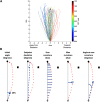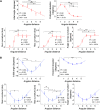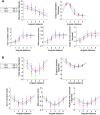Target-Distractor Competition Modulates Saccade Trajectories in Space and Object Space
- PMID: 37263792
- PMCID: PMC10275402
- DOI: 10.1523/ENEURO.0450-22.2023
Target-Distractor Competition Modulates Saccade Trajectories in Space and Object Space
Abstract
Saccade planning and execution can be affected by a multitude of factors present in a target selection task. Recent studies have shown that the similarity between a target and nearby distractors affects the curvature of saccade trajectories, because of target-distractor competition. To further understand the nature of this competition, we varied the distance between and the similarity of complex target and distractor objects in a delayed match-to-sample task to examine their effects on human saccade trajectories and better understand the underlying neural circuitry. For trials with short saccadic reaction times (SRTs) when target-distractor competition is still active, the distractor is attractive and saccade trajectories are deviated toward the distractor. We found a robust effect of distance consistent with saccade vector averaging, whereas the effect of similarity suggested the existence of an object-based suppressive surround. At longer SRTs, there was sufficient time for competition between the objects to complete and the distractor to be repulsive, which resulted in saccade trajectory deviations away from the distractor exhibiting the effects of a spatial suppressive surround. In terms of similarity, as the target-distractor similarity decreased, the initial saccade angle shifted toward the target, reflecting stronger distractor inhibition. There were no interactions between distance and similarity at any point in the time course of target-distractor competition. Together, saccade trajectories reflect target-distractor competition that is affected independently by both spatial and object space suppressive surrounds. The differences in saccade trajectories at short and long SRTs distinguish between active and completed decision-making processes.
Keywords: attention; competiton; object representation; saccade trajectory; suppressive surrounds; target selection.
Copyright © 2023 Giuricich et al.
Conflict of interest statement
The authors declare no competing financial interests.
Figures












References
-
- Boyd JR (2018) A discourse on winning and losing. Maxwell Air Force Base, AL: Air UP.
-
- Cohen MS, Freeman JT, Wolf S (1996) Metarecognition in time-stressed decision making: recognizing, critiquing, and correcting. Hum Factors 38:206–219. 10.1518/001872096779048020 - DOI
Publication types
MeSH terms
LinkOut - more resources
Full Text Sources
